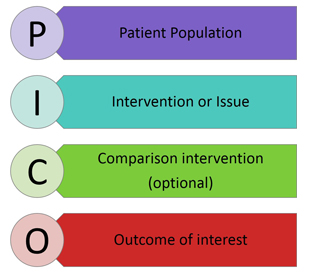
Benefits of PICO Framework
By Jennifer Lawrence
The PICO procedure is a technique that helps in framing a clinical or health-related question and answering it on evidence-based practice. The framework can also help to develop literature search strategies. The PICO is an acronym that stands for:
- P - problem, population or patient
- I - intervention
- C - comparator, control or comparison
- O - outcome
It is of utmost importance for the clinical question to be directly relevant to the patient or the problem being faced. It is to be phrased in such a way that the search for the answer could facilitate in some way. Thus the name PICO is a mnemonic for the important parts of building a proper clinical question. Formulating the search strategies is helped by identifying the key concepts that should be +in the article that answers the question.
Let us take another look at PICO:

- Problem or Patient - What are the most important characteristics of the patient? How can a group of patients be described? How would you describe clinically the problem that they are facing and if they constitute a group?
- Intervention - What is the main intervention technique that you are considering? What would you like to do or how would you want to treat the patient? Would this be the type of intervention technique that you should continue with?
- Comparison - Is there any alternative to this technique? If there is, what is the technique being considered? What are the merits and demerits of each? Which one would be more appropriate for keeping in mind the problem statement?
- Outcome - What is it that you are trying to measure, affect, improve or accomplish?
Sometimes there are some additional questions as well that need to be answered. These are often about the scope of the question
- Type of Question - What is the question about? Is it about diagnosis, therapy, harm, prevention or prognosis?
- Type of Study - If the study would be a case-control, a cohort study, a systematic review or an RCT?
What are the types of questions that are associated with PICO?
Let us look at the primary question types that are involved in the PICO procedure.
- Therapy - It tells how to select the treatments that are to be offered to the patients? Would it be doing more good than harm? Are the treatments really worth efforts and the money that is put in?
- Diagnostic Tests - These tests help to select and interpret the diagnostic tests. They can confirm or exclude a diagnosis based on the precision considered and the expense, accuracy, acceptability and safety
- Etiology - How can the cause of the disease be identified?
- Prognosis - How can the clinical course be estimated over time due to the factors other than interventions?
- Clinical manifestations of disease - It helps to know how often and when the disease would be causing a clinical manifestation and how the knowledge can be used in classifying the illness of the patient.
- Clinical findings - This also helps to properly gather and interpret the findings from the clinical history of the patient and a proper physical examination.
- Clinical manifestation of disease - It is important to know how often and when the disease would cause clinical manifestations. It is also important to know how the knowledge can be used in classifying the illnesses of the patients.
- Qualitative - It is important to empathize with the situations of the patient and appreciate the meaning they find in the experience. This meaning might influence the healing and thus it is very important for a proper cure.
- Prevention - These types of questions arise to discuss how the chances of the disease can be identified and the risk factors can be modified. Also, it leads to answers about how the diseases can be screened early.
- Differential diagnosis - It is used while coming across the possible causes of the clinical problems of the patient and selecting those that could be likely or serious. Also, those which are responsive to treatment can be approached.
What are the benefits of the PICO procedure?
If there isn't a well-focused question, it would be very difficult and time-consuming to identify the proper resources and search for proper evidence. Those who practice evidence-based practice use a specialized framework to form proper questions and facilitate the literature search. PICO is that framework which supports these benefits.
There are some points that have to be kept in mind while questions are formed using PICO. Some of these include:
- The patient would be a member of the population and a person who is at a health risk. Thorough information about the patient should be collected. This helps in making informed decisions and forming answers that would be based on data and not just speculations. Information regarding the ethnicity, socioeconomic status and other demographic variables are also collected.
- The comparison might not always be present in a PICO analysis. The procedure is not about finding the best among a range of available solutions. The procedure helps in finding a solution that would be beneficial and offer the best to patients at the minimum cost to health and money.
- However, the outcomes of these searches should be measurable. The basic evidence is always obtained from rigorous studies that are associated with statistically significant findings. Thus the outcomes obtained would not be hearsay. The advantages can be measured and quantified.
- The outcome would ideally measure the clinical well-being and the overall quality of life. These are not just test results out of the laboratory. These outcomes are based on solid data that can be used in real life scenarios with great effect. Thus PICO procedures offer measurable beneficial solutions that can be used in real life.
- Not only that, the process is not limited to a particular type of domain. It can be changed by considering what type of questions you need to be asking. This might be related to anything from prevention, therapy, diagnosis, etiology or prognosis. One of the most wonderful things about the process is that the questions statements are easy to form once the main elements have been identified.